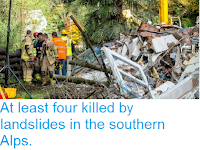Three Spanish skiers have died and two more have been admitted to hospital with injuries following an Avalanche in the Swiss canton of Valais on Saturday 31 March 2018. The party were apparently trying to cross the Aletsch Glacier near Fiesch when they were hit by the event. Rescue efforts were hampered by snow and poor visibility on the day of the event, with the bodies not being discovered until the following morning.
The Aletsch Glacier in Canton Valais, Switzerland, the largest glacier in the Alps. Google Maps.
Avalanches are caused by the mechanical failure of snowpacks;
essentially when the weight of the snow above a certain point exceeds
the carrying capacity of the snow at that point to support its weight.
This can happen for two reasons, because more snow falls upslope,
causing the weight to rise, or because snow begins to melt downslope,
causing the carrying capacity to fall. Avalanches may also be triggered
by other events, such as Earthquakes or rockfalls. Contrary to what is
often seen in films and on television, avalanches are not usually
triggered by loud noises. Because snow forms layers, with each layer
typically occurring due to a different snowfall, and having different
physical properties, multiple avalanches can occur at the same spot,
with the failure of a weaker layer losing to the loss of the snow above
it, but other layers below left in place - to potentially fail later.
Diagrammatic representation of an avalanche, showing how layering of snow contributes to these events. Expedition Earth.
The Alps have seen a number of avalanche related
incidents this winter,
largely due to high levels of snowfall. This is, in turn caused by
warmer conditions over the Atlantic, which leads to higher rates of
evaporation over the ocean, and therefore higher rates of precipitation
over Europe, which falls as snow in cooler regions such as the Alps, where the moist air meets cold air fromt the east.
See also...
Follow Sciency Thoughts on Facebook.








